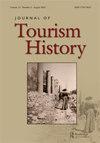The Giant Mountains – as beautiful as the Alps. The origins of the aesthetic discovery of mountains in the Central European context
IF 0.9
Q4 HOSPITALITY, LEISURE, SPORT & TOURISM
引用次数: 0
Abstract
ABSTRACT This article examines the aesthetic motivation behind the inception of tourism in the mountains. Aesthetic motives played a key role in the development of tourism in the Alps, which in the eighteenth century became a new, ideal type of landscape and a popular destination for artists and scientists, and later for tourists too. What form did this phenomenon take in a different geographical and cultural context? What were its dynamics and specific features? The article traces these motives by analysing texts on the Giant Mountains (Riesengebirge, Krkonoše, Karkonosze), which became a favourite destination for tourists from the German states and the Austrian Empire. At the time these mountains were compared with the Alps, and this article aims to analyse the parallels and differences between the aesthetic appreciation of the Alps and of the Giant Mountains. Together with scientific interest, aesthetic concerns also played an important role in the inception of tourism here. We can see a reflection of contemporary theories of the Sublime and the Picturesque, as well as the ascent of romanticism. The article works with sources from the turn of the eighteenth and nineteenth centuries, supplementing them with a summary of subsequent developments in the twentieth century.巨大的山脉——和阿尔卑斯山一样美丽。中欧山水美学发现的起源
摘要本文探讨了山地旅游兴起背后的审美动因。审美动机在阿尔卑斯山旅游业的发展中发挥了关键作用,在18世纪,阿尔卑斯山成为了一种新的理想景观类型,也是艺术家和科学家以及后来游客的热门目的地。在不同的地理和文化背景下,这种现象采取了什么形式?它的动力和具体特点是什么?这篇文章通过分析巨山(Riesengebirge、Krkonoše、Karkonosze)的文本来追溯这些动机,巨山成为德国各州和奥地利帝国游客最喜欢的目的地。本文将这些山脉与阿尔卑斯山进行比较,分析阿尔卑斯山与巨山在审美上的异同。与科学兴趣一起,美学关注也在这里旅游业的兴起中发挥了重要作用。我们可以看到当代“崇高”和“如画”理论的反映,以及浪漫主义的兴起。这篇文章使用了十八世纪和十九世纪之交的资料,并对二十世纪的后续发展进行了总结。
本文章由计算机程序翻译,如有差异,请以英文原文为准。
求助全文
约1分钟内获得全文
求助全文
来源期刊

Journal of Tourism History
HOSPITALITY, LEISURE, SPORT & TOURISM-
CiteScore
0.60
自引率
0.00%
发文量
16
期刊介绍:
The Journal of Tourism History is the primary venue for peer-reviewed scholarship covering all aspects of the evolution of tourism from earliest times to the postwar world. Articles address all regions of the globe and often adopt interdisciplinary approaches for exploring the past. The Journal of Tourism History is particularly (though not exclusively) interested in promoting the study of areas and subjects underrepresented in current scholarship, work for example examining the history of tourism in Asia and Africa, as well as developments that took place before the nineteenth century. In addition to peer-reviewed articles, Journal of Tourism History also features short articles about particularly useful archival collections, book reviews, review essays, and round table discussions that explore developing areas of tourism scholarship. The Editorial Board hopes that these additions will prompt further exploration of issues such as the vectors along which tourism spread, the evolution of specific types of ‘niche’ tourism, and the intersections of tourism history with the environment, medicine, politics, and more.
 求助内容:
求助内容: 应助结果提醒方式:
应助结果提醒方式:


